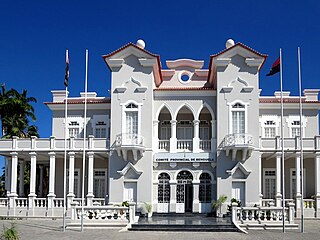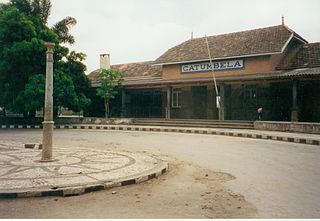
Benguela is a province of Angola, situated in the west of the country. It lies on the Atlantic Ocean, and borders the provinces of Cuanza Sul, Namibe, Huila, and Huambo. The province has an area of 39,826 square kilometres (15,377 sq mi) and its capital is Benguela. According to the 2014 census, there were 2,231,385 inhabitants in the province. The current governor of Benguela is Isaac dos Anjos.

Moçâmedes is a city in southwestern Angola, capital of Namibe Province. The city's current population is 255,000. Founded in 1840 by the Portuguese colonial administration, the city was named Namibe between 1985 and 2016. Moçâmedes has a cool dry climate and desert vegetation, because it is near the Namib Desert.

Namibe Province is a province of Angola. Under Portuguese rule it was the Moçâmedes District. It has an area of 57,091 km2 and had a 2014 census population of 495,326. The port and city of Moçâmedes is the capital of the province with a population of 250,000 in 2014. Iona National Park lies within the province.

Marcelo José das Neves Alves Caetano was a Portuguese politician and scholar. He was the second and last leader of the Estado Novo after succeeding António de Oliveira Salazar. He served as prime minister from 1968 to 1974, when he was overthrown during the Carnation Revolution.

Lobito is a municipality in Angola. It is located in Benguela Province, on the Atlantic Coast north of the Catumbela Estuary. The Lobito municipality had a population of 393,079 in 2014.

Benguela is a city in western Angola, capital of Benguela Province. Benguela is one of Angola's most populous cities with a population of 555,124 in the city and 561,775 in the municipality, at the 2014 census.

Girabola, or Campeonato Nacional de Futebol de Séniores Masculinos, is the top division of Angolan football. It is organized by the Angolan Football Federation.
AP Hotels & Resorts–Tavira–SC Farense, also known as Clube de Ciclismo de Tavira is a Portuguese professional cycling team, founded in 1979, which is based in Tavira, in the Portuguese region of Algarve. It is one of the European teams in the UCI Continental Tour.

Catumbela is a city and municipality of the Benguela province in Angola. The municipality had a population of 175,805 in 2014.
Afro-Portuguese(Afro portugueses or Lusoafricanos), African-Portuguese(Portugueses com ascendência africana), or Black Portuguese are Portuguese people with total or partial ancestry from any of the Sub-Saharan ethnic groups of Africa.

The Archdiocese of Évora is a Latin Church diocese of the Catholic Church in Portugal with Évora Cathedral as its see. It has as suffragans the diocese of Beja and diocese of Faro. The current archbishop of Évora is José Francisco Sanches Alves.

In southwestern Africa, Portuguese Angola was a historical colony of the Portuguese Empire (1575–1951), the overseas province Portuguese West Africa of Estado Novo Portugal (1951–1972), and the State of Angola of the Portuguese Empire (1972–1975). It became the independent People's Republic of Angola in 1975.
The following is a timeline of the history of the city of Lisbon, Portugal.
The following is a timeline of the history of the city of Luanda, Angola.
This is a timeline of Portuguese São Tomé and Príncipe from its discovery between mid-January 1469 to 1471 to independence on July 12, 1975. It includes the time when the island was under Dutch and French occupations and the separate colonies of São Tomé and Príncipe up to its unification in 1753.
Bissau is a city in Guinea-Bissau, a country in West Africa, formerly part of the kingdom of Kaabu and part of the Mali Empire.
The following is a timeline of the history of the city of Beira, Mozambique.
The following is a timeline of the history of the city of Braga, Portugal.
The following is a timeline of the history of the city of Funchal, Madeira, Portugal.
The following is a timeline of the history of the municipality of Setúbal, Portugal.










